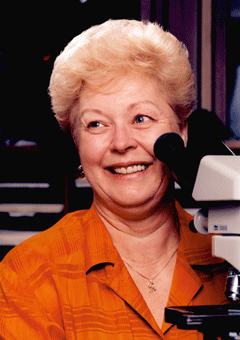Bisphenol A on the Burner
Air Date: Week of August 3, 2007

Dr. Ana Soto. (Courtesy of Dr. Ana Soto)
The government will soon weigh in on the safety of Bisphenol A, an estrogen-mimicking chemical now found in the bodies of most Americans. Bisphenol A is used in plastic toys, bottles and other containers, and a growing body of research shows people are carrying the chemical at levels know to cause immune, neurological and reproductive problems in lab animals. Living on Earth’s Ashley Ahearn reports.
Transcript
CURWOOD: It’s Living on Earth. I’m Steve Curwood. The debate over the safety of Bisphenol A continues to heat up with a number of new studies being published and the establishment of a government panel to review the data.
Invented more than a 100 years ago, Bisphenol A makes a strong and resilient plastic that is used in everything from the lining of tin cans to keep food fresh to polycarbonate baby bottles, anti-cavity tooth sealants, contact lenses, and even the jug in your office water cooler. The chemical mimics the hormone estrogen, and there’s a growing body of scientific knowledge that’s raising concerns about Bisphenol A’s impact on health, from suspected links to breast and prostate cancers to obesity. Living on Earth’s Ashley Ahearn has the latest developments.
[WATER BUBBLER GURGLING]
AHEARN: You don’t have to go far to find Bisphenol A. I’m in the kitchen at Living on Earth right now, standing in front of the water cooler, staring down this large five-gallon jug of water on top. And I’m giving it the evil eye because I know that there is Bisphenol A leaching from this jug into the water that I’m drinking every day. What I don’t know is how concerned I should be about that. I mean, Bisphenol A seems to be everywhere.
SOTO: It’s for certain that some of it will be there.
AHEARN: That’s Dr. Ana Soto. She’s a professor in the department of anatomy and cell biology at Tufts University, and has been studying estrogen imitators, like Bisphenol A, since they were first accidentally discovered to be leaching from plastics in the lab, into lab animals back in 1989.

Dr. Ana Soto. (Courtesy of Dr. Ana Soto)
AHEARN: Bisphenol A, or BPA is a chemical compound that mimics estrogen and when it gets in our body, it sends mixed messages to our endocrine system, especially if we’re exposed to it in the womb or as small children.
When lab mice and rats are exposed to BPA at levels similar to those currently found in humans, they show altered behavior and menstrual cycles and an increase in prostate cancer, breast cancer and type II diabetes. Dr. Soto says it’s time to start looking in the mirror because these are people problems too.
SOTO: So for example we know that there is an increase in prostate and breast cancer incidence, early onset of puberty in girls, metabolic disorders like insulin resistance, type II diabetes and obesity, and neurobehavioral problems. So you see, there is a parallel.
AHEARN: New research also draws a parallel between Bisphenol A and Diethylsylbestrol, or DES, a drug that was prescribed to pregnant women from the 40’s to the 70’s to prevent miscarriages with famously sad consequences.
NEWBOLD: It was later shown to be associated with cancer in the daughters of the women who took it while they were pregnant.
AHEARN: That’s Retha Newbold, a developmental reproductive biologist for the National Institute of Environmental Health Sciences. She conducted the research on DES and Bisphenol A.
Scientists and policy makers are sometimes hesitant about applying results found in lab animals to people. But Retha Newbold says the documented human health impacts of DES offer a precautionary tale that should be applied to Bisphenol A.

Retha Newbold (Courtesy of NIEHS)
AHEARN: Newbold’s research found some surprising parallel health impacts to mice exposed to DES and mice exposed to Bisphenol A.
NEWBOLD: If we expose animals to DES during development we get a pretty high instance of cystic ovaries and we get that same high incidence with Bisphenol A. We also see an increased incidence in a tumor that would be called uterine fibroids.
AHEARN: Retha Newbold, Dr. Ana Soto and 36 other scientific experts on Bisphenol A and reproductive health, have just signed a consensus statement saying that amount of BPA routinely found in the blood of Americans is higher than levels that produce a wide range of negative health effects in animals.
Right now the exposure limit set by the EPA for Bisphenol A is two thousand
times greater than the relative levels where Dr. Soto sees effects on her lab animals. She says more needs to be done to eliminate Bisphenol A from products used by the general public.
SOTO: At this moment, I think that the government has to start regulating to lower the exposure of pregnant women and children.
AHEARN: But not all scientists are convinced that BPA is a serious health risk. Robert Chapin is the chair of the panel convening next week, under the National Toxicology Program, to draft a document that will advise the government on the risks of BPA. He’s also a research advisor for the Pfizer pharmaceutical company.

Robert Chapin (Courtesy of Robert Chapin)
AHEARN: As the scientific debate reaches the boiling point, some political leaders are beginning to take action. Proposed legislation banning Bisphenol A in children’s products in California, Maryland, and Minnesota was defeated. But, Japan did ban Bisphenol A in canned food and found that levels of the chemical fell in human beings by 50%.
San Francisco banned infant and children’s products containing Bisphenol A last summer, but the ban was repealed after chemical and toy companies filed lawsuits.
When it comes to the choices we make at home, environmental health advocates recommend people avoid canned food and hard, clear plastic bottles and other plastic containers, especially if they’re starting to show signs of wear because BPA leeches more as plastic ages.
For Living on Earth, I’m Ashley Ahearn.
[MUSIC: Morphine “I Had My Chance” “Get Shorty Soundtrack” (PolyGram Records, Inc. – 1995]
Links
National Toxicology Program Panel
The consensus statement of 38 scientific experts outlining concerns about Bisphenol A.
Living on Earth wants to hear from you!
Living on Earth
62 Calef Highway, Suite 212
Lee, NH 03861
Telephone: 617-287-4121
E-mail: comments@loe.org
Newsletter [Click here]
Donate to Living on Earth!
Living on Earth is an independent media program and relies entirely on contributions from listeners and institutions supporting public service. Please donate now to preserve an independent environmental voice.
NewsletterLiving on Earth offers a weekly delivery of the show's rundown to your mailbox. Sign up for our newsletter today!
 Sailors For The Sea: Be the change you want to sea.
Sailors For The Sea: Be the change you want to sea.
 The Grantham Foundation for the Protection of the Environment: Committed to protecting and improving the health of the global environment.
The Grantham Foundation for the Protection of the Environment: Committed to protecting and improving the health of the global environment.
 Contribute to Living on Earth and receive, as our gift to you, an archival print of one of Mark Seth Lender's extraordinary wildlife photographs. Follow the link to see Mark's current collection of photographs.
Contribute to Living on Earth and receive, as our gift to you, an archival print of one of Mark Seth Lender's extraordinary wildlife photographs. Follow the link to see Mark's current collection of photographs.
 Buy a signed copy of Mark Seth Lender's book Smeagull the Seagull & support Living on Earth
Buy a signed copy of Mark Seth Lender's book Smeagull the Seagull & support Living on Earth

